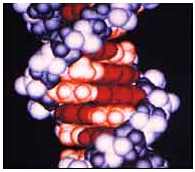DNA means deoxyribo-nucleic acid.
It is found in virtually every cell in the body. It carries genetic information from one generation to another and determines physical characteristics like hair and eye colour.
This genetic information is in the form of a code.

Except for identical twins, DNA is unique to each person.
Half of the DNA is inherited from our father and the other half from our mother. Brothers and sisters may inherit different combinations of DNA from the same parents and are therefore different from each other.
Techniques used in forensic science look at specific areas of nuclear DNA, which are known to vary in length between different people. DNA profiling analyses and measures these differences. DNA can be extracted from any cells that contain a structure called the nucleus. This includes blood, semen, saliva or hair samples.
Mitochondrial DNA is a form of DNA found in small components of a human cell called mitochondria. It is inherited only from the mother and does not show paternal characteristics. This means that brothers and sisters will have the same mitochondrial DNA type as their mother, as will any relative linked through the female line.
Many copies of this DNA are present in a cell. Therefore in badly degraded or old tissue where the single copy of nuclear DNA has broken down it is possible to find sufficient intact parts of the mitochondrial DNA for analysis. However, it is much shorter in length than the nuclear DNA and consequently has fewer features with which to observe differences between individuals.
Mitochondrial DNA testing involves two related techniques. Mitochondrial sequencing was introduced into forensic casework in 1994, and mitochondrial mini-sequencing that was introduced at the beginning of 1998. Both techniques are extremely sensitive, and are most useful for discrete samples - ones that are unlikely to contain DNA from more than one body fluid.
Here is an example of the British Police's Forensic Science Service used such test to help solve a crime.
The Jill Dando Case
A careful use of forensic science provided a microscopic particle of gunpowder only eleven microns in size. This tiny particle helped to convict Barry George in 2001 for the murder of TV presenter Jill Dando. The firearms discharge residue was found by a forensic scientist as he searched a coat belonging to Barry George, the man suspected of killing Jill Dando.

This scientist gave crucial and complex evidence in a case that was followed by millions.
Scientific explanations
In court he told how, when a gun is fired, minute particles of discharge residue are propelled away from the weapon and can be detected on the hands, face and clothes of the person who fired it.
But in this case, as the gun had been in direct contact with Miss Dando's temple, much of the material went into the bullet wound with only a small amount escaping.
Firearms discharge residue contains different components but there are five common sorts - and the type found in the pocket of George's coat could have been produced by the fired cartridge case found at the scene.
Discharge residue will be retained in pockets for long periods. Although the coat was not examined until more than a year after the shooting, all parts of it were examined because forensic scientists like to do a thorough job.
The gun used to kill Miss Dando was never found, but another senior firearms examiner gave evidence to the court about the type of weapon it may have been.
He was able to deduce from a cartridge case found at the scene that it was a 9mm (short) self-loading pistol and he was intrigued by six puncture marks around the cartridge case. The crimping served no purpose as the bullet would have been tight in the case and it had not been fired before.
Another interesting factor was the bullet had been fired from a smooth-bored barrel. A conventional pistol would have a rifled barrel, designed to spin the bullet and give it stability as it flies through the air.
Incriminating fibres
A third scientist had found that a blue/grey polyester fibre on the Jill Dando's coat matched fibres from a pair of trousers found at George's home.
He was also responsible for blood spatter pattern work and DNA profiling on minute blood stains found on clothing belonging to both the suspect and Miss Dando - but found nothing to connect them.
The fourth expert told the court he examined three footwear marks found at the crime scene. Two originated from ambulance crew but the third partial mark on the doorstep had been made by a shoe which was 'very wet' - but was unable to say this was blood.
He said there was not enough of a mark to enable him to size the shoe and he could not say how long it was there. Although he examined shoes found at George's address he could not find a match.
In December 2002 Barry George who claims his conviction is "unsafe" was refused permission by the House of Lords to take his appeal to a higher court.
Adapted from Forensic Science Service reports.